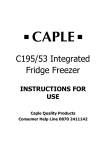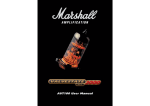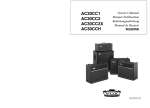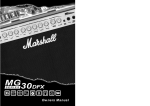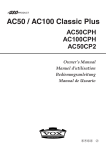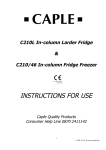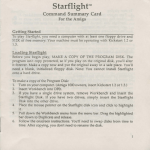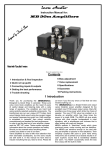Download ue to the over enthusiastic and often obsequious scrawlings of
Transcript
D ue to the over enthusiastic and often obsequious scrawlings of countless amplifier reviewers, the phrase “best of both worlds” has lost a lot of its impact and intrigue. Seemingly, any amp with more than one channel, or capable of more than one sound qualifies for said label! Joking(?!) aside, the “best of both worlds” label definitely applies to VOX’s latest all-valve variant of the legendary* AC30, the Custom Classic. Why? Because, as you’re about to find out, the AC30 Custom Classic truly does represent the best of the tried-and-tested AC30s, mixed in with some of the reviewer and player-approved features of more recent family members such as the AC15 Top Boost Reverb (R.I.P.) and the handwired AC30HW. Plus, there are a few new niceties added in for increased tonal flexibility – while maintaining the sonic integrity that has made the AC30 a ‘must have’ amplifier for so many over the past 45 years (yes folks, it is really that long since Dick Denney and Tom Jennings gave birth to the first brood of this classic combo back in 1959)... *Note: We, of course, realize that “legendary” is another term whose meaningfulness has drastically declined due to much overuse and abuse – this stated, the AC30 truly is a “legend” in the guitar amplifier realm and is therefore deserving of the title. After all, how many other 45 year old amplifiers have remained both available and in-demand throughout their life-spans? And let’s also not forget that it literally was the amp behind the guitarists that led the charge in the famous “British Invasion” of the mid-1960s. There now follows an overview of the VOX Custom Classic which, for the sake of ease of digestion, has been broken down into “bite-sized” chunks... WHAT IS IT? As just hinted, the mindset behind the design and development of the new AC30 Custom Classic was to combine the most desirable and popular features of old and new VOX allvalve ACs into one amplifier...and throw a few equally desirable new design features into the mix too – hence the name, Custom Classic. To whet your appetite a little, the ‘custom’ features include a Master Volume; Spring Reverb with Dwell and Tone controls; fully adjustable Tremolo; a channel Blending Input Link switch for its two channels – Normal and Top Boost; Standard/Custom EQ switch on the Top Boost channel; switchable Cathode bias resistor values for lower power; Switchable Vintage/Modern Smoothing cap values for a looser or tighter feel; and a bypassable, series Effects Loop with variable level. Actually, before we go any further, even though I’m literally talking about “one amplifier” here, there are several different configurations of this “one amplifier” available so let me quickly introduce you to the Custom Classic family... As indicated by the above family portrait, there are in fact several amplifiers in the Custom Classic clan – namely, three different combos (a pair of 2x12s and a 1x12) plus a head – and several extension cabinets (two 2x12 options and a 4x12). We’ll discuss the exact specifics (namely the speaker/cabinet options available) of these configurations later...and, yes, incase you’re wondering, one of the two 2x12” combo offerings does indeed boast VOX/Celestion Blue Alnico speakers. Family introduction over, back to the specifics of the amplifier section that’s common to the three Custom Classic combos and the head... VALVE COMPLIMENT The AC30 Custom Classic employs a total of seven valves – 3 x ECC83s in its preamp, a GZ34 rectifier and a quartet of EL84s working in push-pull pairs. The reason the AC30 Custom Classic has three less preamp valves than the original AC30TB that boasted 5 x ECC83s and 1 x ECC82. Because the Custom Classic doesn’t feature a Vib-Trem channel, the rarely used and least favorite of the AC30TB’s trio of channel options – namely: Top Boost, Normal and Vib-Trem. Another benefit of ditching this effectively vestigial offering? Staggering as it may seem, the Vib-Trem channel is responsible for over 50% of the preamp components in the AC30TB! As you’ll discover later, in addition to tone and flexibility, attaining a more affordable price point was very high on VOX’s “Must Achieve” goal list for the Custom Classic. A QUESTION OF CLASS A frequent topic of discussion amongst amp aficionados in bars, stores and on bulletin boards the world over is this: Is the AC30 a class A amp? The answer is, in a word, yes and no . “A lot of people call it class A because it’s a cathode-biased class AB amp,” VOX’s chief designer, Steve Grindrod, explains. “If it was actually biased to full class A you’d be lucky to get 12 Watts out of it! Plus it would generate an awful lot more heat than it actually does. The AC30 acts as a Class A amp until the signal level hits a certain point. But it is actually a class AB1* amplifier which is the next classification along from class A, so it has a lot of class A influence in the way it compresses and delivers the sound. But, once you start to overdrive the amp, that’s when you really can tell the difference between a true class A amp and what an AC30 actually is...the AC30 is much more efficient and also distorts more than a class A circuit.” A very important point! It should be pointed out that the AC30 Custom Classic is no less Class A than all prior iterations of the AC30, from JMI through today, and other so called Class A amplifiers, most of which have cathode biased EL84 output valves. *Note: Defining Class A operation as the bias being set so there is continuous anode (plate) current in each output valve throughout the input cycle (i.e. 360 degrees); class AB operation as the bias being adjusted so that anode current flows for more than 50% (180 degrees) but less than 100% (360 degrees) of the input cycle; and class B for no more than 50% of the cycle. Where does class AB1 sit in all this? Well, class AB is subdivided into AB1 and AB2 with class AB1 having a slightly higher bias than class A with a larger input signal (having amplitudes reaching, but not exceeding, the cutoff) and being defined as class AB operation where grid current doesn’t flow for any portion of the input cycle. IMPORTANT NOTE: As you will discover later, due to the Output Bias switch on the rear panel of the Custom Classic it also operates as a class AB2 amp when the “Warm” setting is chosen – this will be covered (and class AB2 defined) in the ‘Rear Panel Features’ section later on. At this point of the proceedings, the best and also probably the quickest way to learn about the Custom Classic’s features and inner workings is to take a studied walk through its two panels – top (control) and rear. Whenever something new and/or of interest is being discussed, it’ll either get its own subheading or will appear in bold type for easier navigation through this piece... TOP PANEL LAYOUT As the following picture illustrates, the AC30 Custom Classic’s top panel is, for the most part, pretty self-explanatory. We’ll scan it from left-to-right, in an almost “user manual” fashion: INPUT SECTION As you can see, it has two inputs – one for each of its channels: Top Boost (top input) and Normal (bottom input). Now the obvious has been stated, let’s zone in on the Input Link switch. As its name suggests, this mini toggle switch gives you the option of using each channel separately or blending the two of them together. When this switch is in the ‘up’ position, the two channels are independent; when it is ‘down,’ providing you’re plugged into the Top Boost input, the two channels are linked so you can blend them together via their controls. Note: If the Input Link switch is “on” but you’re plugged into the Normal input, no blending occurs – you have to be plugged into the Top Boost input for that to occur. NORMAL CHANNEL PREAMP CONTROLS This minimalistic single knob, single toggle-switch section controls the Normal channel’s preamp. The Volume allows you to set the gain sensitivity of the channel’s preamp and obviously determines how clean or how dirty the sound is. As the name of the Brilliance switch on this channel suggests, engaging it (i.e. putting it in the ‘down’ position) adds top end brightness to the channel’s tone. It achieves this by introducing a ‘bright cap’ across the volume pot which introduces a high frequency pre-emphasis, a la the bright switch on a Fender. This stated, the Custom Classic’s Brilliance switch is much more effective than a regular bright switch because it also introduces a resistor into the circuit as well – the result of which is that the ‘bright cap’ is varyingly effective over the entire range of the volume pot, as opposed to only being effective at low volume settings as is the case with a typical Fender-type bright switch which only kicks in a ‘bright cap’ by itself. It may also interest you to know that due to its function, the Brilliance switch converts the Custom Classic’s Normal channel into something very similar to the Normal channel found on a vintage Treble* AC30/6. *Historical Note: Prior to the advent of the popular Top Boost version of the AC30 in the early ‘60s, the AC30TB (TB = Top Boost, imagine that!), AC30s were available in three subtly different yet distinctive tonal flavors – Bass, Normal and Treble. TOP BOOST CHANNEL PREAMP CONTROLS This channel features the Top Boost circuitry that was designed back in 1961 and quickly became ‘the norm.’ In addition to the all-too-familiar trio of chicken-head knobs marked Volume, Treble and Bass, the Custom Classic’s Top Boost channel also features an EQ switch, the function of which is deserving of its own section... *Historical Aside: The now famous Top Boost circuitry came about following requests from artists for the AC30 to offer more tonal flexibility and a hair more gain too. Dick Denney reacted quickly and devised some extra tone circuitry for the combo’s Brilliant channel which introduced an extra ECC83 preamp valve plus two EQ controls – one for Treble, the other for Bass. When it was first introduced, VOX called this extra circuitry their “Brilliance” unit and it was initially only available as a retrofit assembly that could be added to the back panel of an AC30/6. To be exact, the “Brilliance” unit was an ‘L’ shaped bracket with the ECC83 facing sideways, a pair of vertically aligned tone pots that faced the back and a white face plate simply marked Bass and Treble. This unit quickly became known as ‘Top Boost’ and in 1961 was offered as a factory fitted option to the AC30 with the controls on the top panel as opposed to the back, and so the AC30TB was born. STANDARD/CUSTOM EQ SWITCH This mini-toggle switch offers you two passive* EQ options on the Top Boost channel: Standard (switch ‘up’) and Custom (switch ‘down’). Simply put, Standard gives you the classic, highly interactive VOX AC30TB tone stack. Switching to Custom reconfigures the components into something closer to the far more common circuit as used by many, many companies including those beginning with “F” and “M” – so, if truth be told, it could be argued that the Custom EQ option is really more ‘standard’ than the Standard option! FYI, the Custom tone stack option is what is used on the Top Boost channels of both the handwired VOX AC30HW and also the ‘90s AC15 offering. *Note: Passive tone controls only attenuate (reduce) certain frequencies; they don’t boost anything – that’s what ‘active’ controls do. What’s the difference between these two EQ options? Simply put, while the Custom setting is somewhat interactive, the Standard is far more so. When both tone controls, Bass and Treble, are set at 12 o’clock (halfway) the difference between the two EQ settings are so minimal they’re almost inaudible. Once either or both controls are turned up though, the difference becomes more and more obvious. As the Bass control is turned clockwise, the mid scoop (cut) in the Standard EQ setting is far, far more pronounced than in the Custom setting. Also, when Custom is chosen, adjusting either control has less affect on the other one which is not the case of the Standard setting due to the dramatic effect both controls have on the mid frequencies – in particular the Bass knob. Hot Gossip*: It is generally felt amongst VOX aficionados that the extreme interactivity of the original AC30TB’s tone controls actually came about because a mistake was made in the way the Bass pot was originally wired. Unfortunately, as both Dick Denney and Tom Jennings have now passed on, we can’t prove or disprove this ‘urban legend’ though! It would appear, however, that this “error” could well have been ‘borrowed’ from the Gibson GA-70 and GA-77, a pair of 1x15” combos that had been available since the mid ‘50s and acknowledged as having a high gain channel with tone controls for Treble and Bass. As it turns out, the original Gibson schematics for these two amps feature the same exact ‘error’ on the Bass pot – namely grounding one end that should’ve been left open – and the exact same components also used in the VOX ‘Top Boost’ unit. The result of this ‘error’? As already mentioned, a Bass control that also effects the mids, and even the top to a degree when turned up full. *Credit Where Credit is Due: the following web address provided some valuable information pertaining to this little aside and is well worth checking out: http://www.geocities.com/vintage325/topboost.html WHICH PREAMP TUBE DOES WHAT? If we label the three ECC83 preamp valves V1, V2 and V3 in the Custom Classic’s preamp as shown below, here’s how the labor is divided between this trio of dual triode devices: V1: half of this dual triode is dedicated to the Normal channel, the other half to the Top Boost channel. V2: dedicated totally to the Top Boost Channel – half is used as a gain stage, the other as the tone driver V3: phase splitter REVERB SECTION The footswitchable (footswitch supplied) Reverb is universal (i.e. works on both channels) and is controlled by two knobs –Tone and Mix – plus a Dwell switch which offers two settings: Low Drive and High Drive. As the reverb circuit itself boasts a unique design, let’s look at that first and then we’ll get into what the controls and switch do... In the analog domain there are basically two types of spring reverb drive and recovery circuitry used in guitar amps – valve and, in more recent times, solid-state. Both have their own list of pros and cons. A valve circuit has an inherent soft-clipping characteristic that’s rich in even-order harmonics and is pleasing in terms of both sound and feel. As such a circuit invariably involves a transformer it is relatively expensive. Other drawbacks of a valve driven circuit are that the valve creates heat and does eventually wear out with use. Also, particularly with high-gain circuits, there’s a lot of radiation from the wiring and the transformer and these can cause instability and noise in such a circuit – you can, of course, design around these problems but doing so obviously increases price. On the other hand, the solid-state option is cheaper but has less headroom and a harsh clipping characteristic in the drive circuit. As already mentioned earlier, one of the primary goals with the Custom Classic was not only to make the most versatile and best sounding AC30 ever, but also to make it the most affordable version too. Because of this, a solid-state reverb drive/recovery was chosen and chief designer Steve Grindrod decided to develop a brand-new circuit. “Although some of the solid state reverb circuits already out there are pretty good,” Grindrod states, “it has always been my impression that no-one, and I include myself here, has taken them far enough in getting a really good sound or maximum benefit out of the reverb. One of my goals with VOX was to design cost-effectively but never to skimp on quality of design or build. I’ve always been interested in the capabilities of FETS and MOSFETS in getting close to tube-like characteristics for a number of reasons. Obviously they are a lot cheaper and, providing you use the right ones, their life cycle is a lot higher than that of valves because they don’t wear out! “In my investigations I discovered that the majority of MOSFETS are not suited for the purpose I have in mind because of what they’ve been specifically designed for, which isn’t guitar amps! This said, I’ve managed to find a special MOSFET that works in the same mode that a valve does and, even though its gain characteristics are slightly different, you could unplug a valve from an amp’s preamp circuit, solder this MOSFET in its place and the amp would work without you having to change or add any other components. And, being a MOSFET, it has the even order harmonics similar to those you get from a valve too. So I experimented with this device and I’m using it in both the drive and recovery stages of the Custom Classic’s reverb to emulate the soft clipping that naturally occurs in a valve circuit. “At this stage I could’ve used a transformer in the circuit but it’s an expensive item and not totally ideal,” Grindrod continues. “So, instead, I’ve used five special op-amps in parallel and as they are 60 volt devices as opposed to the regular 30 volt ones they give me a lot of headroom and also provide a great deal of current/drive capability without saturation. Furthermore, they’re also wired in a circuit configuration that emulates the behavior and characteristics of a transformer.” The Reverb’s Tone control is a simple, passive high-cut that allows you to make the reverb brighter or darker sounding depending on how you set it. The Mix control also needs little or no explanation – it controls the amount (mix) of reverb you have in your sound. This just leaves us with the mini toggle switch marked Dwell... The Dwell switch allows you to select a Low (switch ‘up’) or High (switch ‘down’) Drive setting. Why is this useful and how and when should it be used? Over to Mr. Grindrod once again: “When using spring reverb you need to be driving it as hard as possible on the input in order to maximize the signal-to-noise ratio while getting good reverb depth,” he explains. “If the circuit is not driving the springs hard enough then you’ve got to add more gain to the recovery stage which only serves to add noise and also possibly instigate instability and feedback. “Most guitar amp reverb units have drawbacks because you have to compromise how much drive you put it in verses how clean the amp’s got to perform or how overdriven the amp’s got to perform. Obviously, if the preamp’s running clean it is not going to be driving a lot of signal into the reverb. Conversely, if the preamp is turned up then there’s going to be a much higher signal which then starts saturating the reverb and you get that undesirable ‘crashiness’ occurring. Consequently, from a design point of view, it’s always a compromise between how much you can drive and how much you can recover. And this is where the Dwell switch comes in... “This switch gives you two drive levels into the reverb to choose from – Low and High. So, if you’ve got the amp set-up to sound super-clean and you want a lot of reverb, you can increase the level of drive into the reverb by selecting High Dwell (switch ‘down’). Likewise, if you’re running the preamp a lot hotter you can turn the reverb drive level down by selecting ‘Low Drive’ (switch ‘up’) and the reverb tank is being driven at a more suitable level without risk of saturation or ‘crashiness.’” The reverb unit used in the Custom Classic is a three-dual-spring, large tank that is housed in a padded vinyl bag to isolate the springs from vibration and, in the case of the three combos, prevent acoustic coupling with the speakers so there’s less chance of feedback. Naked Classic: The C.C.’s chassis, large reverb tank and padded vinyl bag TREMOLO SECTION The Custom Classic’s Tremolo, like the Reverb, is footswitchable (footswitch supplied) and works on both channels. It has two chicken-head knobs marked Speed and Depth, both of which control exactly what their labels suggest. The Tremolo circuit itself is identical to the one found in the AC15 and the AC30HW except for the fact it uses the aforementioned “special” MOSFET as its oscillator instead of a valve. “I did this because of the varying nature of valves from manufacturer to manufacturer and the fact that with a valve oscillator you’re running it right at its upper limit. This means that when you change valves, the speed and depth of the effect can and will vary, or may not even work at all depending on how similar or dissimilar the two valves are,” Grindrod states. “It also means that the performance of the Tremolo circuit will be somewhat different from amp to amp. This is obviously a far from ideal scenario but, unfortunately, a reality given the aforementioned variance in valves. By using the MOSFET instead of a valve however, I’ve not only made the circuit totally constant from amp to amp, I’ve also managed to make the slow-to-fast range on the Speed control a little wider because the special MOSFET I’m using has slightly more gain than the valve.” POWER AMP CONTROL SECTION This final section of the top panel’s control area contains two knobs marked Tone Cut and, the self-explanatory, Master Volume – the later being another ‘custom’ feature found on the AC30HW and the three ‘90s AC15 offerings that adds versatility to the Custom Classic for the obvious reasons – it allows the user to crank the CC’s preamp sections while maintaining control over how loud (or quiet) the actual output volume is. As the ‘classic’ Tone Cut’s name might suggest, it works in the opposite way that most tone controls work in that the high frequencies decrease as you turn it clockwise, and vice-versa. While the Tone Cut works in the power amp section of the amp, because the Custom Classic’s power stage does not feature a negative feedback circuit, it shouldn’t be confused with a Presence control, which works by altering the aforementioned feedback circuit. Instead the Tone Cut is a passive treble roll-off control, which is wired across the two outputs of the phase inverter valve. Just like the tone control in a guitar, except working in reverse, all it consists of is a capacitor wired in series with a pot. What this does is frequency-selectively short the two outputs of the phase inverter together so, as the control is turned clockwise, there’s less high frequencies being sent to the quartet of EL84 output valves. REAR PANEL FEATURES Here’s where several interesting ‘custom’ features also lurk... LOUDSPEAKER OUTPUT JACKS & O/P SWITCH A straightforward but useful feature is the ability to use an external cabinet in conjunction with the internal speaker(s) in any and all of the three Custom Classic combos. This is simply done by using the ¼” Loudspeaker Output jack labeled ‘Extension’ (which runs in parallel to the internal speaker(s)) and obeying Ohm’s Law via the OP Select switch that allows you to choose between 8 and 16 Ohm settings. Simply put, because the internal speakers in all three combos are wired for 16 Ohms, you have to use a 16 Ohm extension cabinet and set the OP Select Switch to 8 Ohms...that’s the only game in town. Also on offer is the chance to disconnect the combo’s internal speaker(s) and drive one or two extension cabs – once again, making sure the Ohm’s Law is strictly obeyed at all times...unless, of course, you enjoy paying for expensive repairs induced by impedance ignorance! This is done via the Loudspeaker Output labeled ‘External’ which, when used, automatically disconnects the internal speakers. Once again, your options are somewhat limited as only 8 Ohm or 16 Ohm selections are possible. Here are your options – and if you’re familiar with Ohm’s Law, please jump straight to the next section: Output Bias... 1) If you choose to run a single extension cabinet without employing the combo’s internal speaker(s), then you can plug either a 16 Ohm or 8 Ohm cabinet into the ‘Extension’ jack and set the OP Select switch accordingly. 2) If you opt to run two extension cabinets, they each have to be 16 Ohms. You then set the OP Select to 8 Ohms and use both Loudspeaker Outputs. OUTPUT BIAS SWITCH This switch allows you to choose one of two specific bias settings for the output valves in the Custom Classic: ‘Warm’ or ‘Hot.’ It does this by switching between two different values of cathode resistors, which sit between the cathodes of the EL84 output valves and ground – the Custom Classic being a cathode biased beast... When ‘Hot’ is selected, the cathode bias value is set to 50 Ohms which is the norm for the vast majority of six-input AC30s. When ‘Hot’ is selected, as its name suggest, the output valves run hot and the amplifier’s clean output power (i.e. before clipping occurs) is approximately 33 Watts – providing a goodly amount of clean headroom. FYI, at this setting the amplifier is operating in class AB1. When ‘Warm’ is selected, the cathode bias resistance is set to 82 Ohms, which is similar to early four-input AC30s. As a result of this the output valves run cooler than they do in ‘Hot’ mode and the clean headroom is reduced. In fact, the amplifier’s clean output power drops to approximately 22 Watts. This result is an output stage that distorts at (relatively) lower volumes because the re-bias reduces the power produced at clipping. It also prolongs valve life and introduces some subtle but noticeable cross-over distortion as a result. Another side effect of the ‘Warm’ setting is that the amp operates in class AB2.* *Note: class AB2 has a higher bias than class AB1 and is closer to class B than A. Class AB2 is defined as class AB operation (see earlier definition) where grid current flows for some portion on the input cycle (as you may remember, in class AB1 grid current does not flow for any portion of the input cycle). SMOOTHING SWITCH This switch allows you to choose between two different smoothing capacitor values for the mains power supply to the valves – Vintage and Modern. In the Vintage position it sets the smoothing capacitors to the low micro-farad value (22µF) which is similar to the 16µF found in earlier VOX amps, while the “Modern” position switches to the higher value (44µF) which is akin to the recent AC30HW which hosted 50µF. Sonically speaking, the difference between the two settings is this: the higher, modern capacitor values make their smoothing function more efficient, thus reducing the sag* somewhat, eliminating most of the ghosting on the notes, and improves bass response** – making the amp more immediate. It also reduces hum – this said, compared to a ‘regular’ AC30, the hum produced by the Custom Classic when its Smoothing switch is set to “Vintage” is minimal. The reasons for this noise-related improvement will be explained later in the ‘Chassis’ segment of the UNDER THE HOOD section that follows shortly. Read on.... *NOTE 1: The term ‘sag’ is used to describe the drop in power supply voltage that can occur when smoothing capacitors can’t keep up with the amplifier’s demands when a note or chord is being played. When this occurs, the so-called ‘sag’ manifests itself as a slight volume drop, similar in effect to that of a compressor. In the Modern setting the larger values make the caps more efficient and, therefore, better able to keep-up with current draw. Hence the reason the Modern setting results in the amp having a more immediate response. **NOTE 2: The reason the bass response improves in the Modern setting is simply because low frequency notes require the most power (current draw). So, with the higher values a drop in power is less likely because of the smoothing sections increased (wait for it) capacity to meet demand. FX LOOP The inclusion of a Series effects loop is another ‘custom’ feature of the Custom Classic and a first for the AC30 family. To add to both the flexibility and the non-invasive nature of the Custom Classic’s FX loop, it boasts switches for Level (-10dB for stomp box type effects, +4dB for rack processors) and Bypass. Furthermore, the FX loop has been designed to work specifically with the Custom Classic so that your Tone has not been compromised in any way whether the loop is in-circuit or Bypassed. FOOTSWITCH The Custom Classic comes supplied with a diecast, two-way footswitch which is connected to the amp via a jack socket on the rear panel and allows the user to switch the Reverb (A) and Tremolo (B) on/off SPEAKER OPTIONS Thus far, we’ve talked about Custom Classic amplifier features that are common to all four of its members – the head and three combos. At this point let’s take a quick look at the speaker options that are available in the trio of combos and also the three Custom Classic extension cabinets that are on offer. We’ll begin with the combos, the AC30CC2X, AC30CC2 and AC30CC1. The reason for there being three combo options? To cover a variety of tonal, size and price-point preferences/needs... CUSTOM CLASSIC COMBOS AC30CC2X: one of the most important features included on this classic 2x12” combo is the use of Celestion alnico (a name derived from the aluminium , nickel and cobalt composition of the speaker magnet) ‘VOX Blues.’ The famous T530 12”, 15-Watt guitar speakers Celestion made exclusively for VOX in the early ‘60s. Front and rear shots of the AC30CC2X AC30CC2: a 2x12” combo that houses a pair of VOX custom-voiced GSH12-30 speakers. Now, as a general rule of thumb, ‘custom-voiced’ means a speaker made by ‘no-name’ manufacturer to the exact specifications – not that there’s anything wrong with ‘no-name’ OEMs, there are some very good sounding ‘custom-voiced’ speakers out there but, that said, there are also some clunkers – mind you, the same could be said for ‘name’ brands too! In the case of the GSH12-30 though, the speaker manufacturer is hardly a ‘no-name’ – it’s Wharfedale, the well-respected hi-fi brand and England’s oldest speaker maker. Furthermore, the gentleman in charge of Wharfedale’s speaker manufacturer is well-versed in the design of guitar speakers having spent a lot of time working for Celestion and Fane in the ‘60s and‘70s. Add the name Steve Grindrod into the “let’s build a custom speaker” VOX/Wharfedale equation, and it gets even more interesting as Grindrod was instrumental in the development of quite a few Celestion speakers, including one of today’s most popular modern-day 12” guitar speakers – originally named the Marshall/Celestion “Vintage” but now mass-marketed under the much more familiar but rather confusing and misleading name of “Vintage 30.” Why do I say “confusing and misleading?” Well, it’s confusing because it is not a 30-Watt speaker (but due to its name is often referred to as one – it’s actually 60 or 70 watt, depending on how conservative the rating chart you read is!) and it’s also misleading because to some folk, logic dictates that the “30” implies it was voiced to sound like a vintage 30-watt speaker which is not the case. “That speaker was originally designed for use with the Marshall Studio 15 combo (model 4001) and the goal was to try and re-create the ‘vibe’ of a 15-Watt Celestion Alnico speaker but with a higher power handling capability (60 to 70-Watts) and a much lower cost”, confirms Grindrod. “At the time in question, 1983 to ’84, redoing the Alnico was completely out of the question because the so-called ‘cold-war’ was still a reality, supplies of Cobalt were extremely limited and, even when it was obtainable, the price was totally ridiculous! To be honest, we didn’t get the exact result I was hoping for but ended up with a magnificent sounding speaker!” As Grindrod is quick to point out though, the new GSH12-30 is voiced to sound like a 30-watter – specifically a classic, British made 30-watt, 12” guitar speaker of the ‘60s. “I’m delighted with the results,” he concludes. In addition to offering a different tone to the widely accepted, ‘classic’ tone of the ‘Blues’, the AC30CC2 is also a good deal cheaper than the AC30CC2X due to the relative cost of the speakers. AC30CC1: this 1x12” version of the Custom Classic houses a proprietary 12”, 60-Watt Celestion neodymium speaker called the NeoDog. This speaker has been voiced to have good even response across the guitar’s frequency range and, thanks to the use of a neodymium magnet, is a relatively light speaker. The combination of this fact with the slightly smaller cabinet size a 1x12” speaker configuration affords, results in a Custom Classic combo that’s extremely portable. Why is the price of the AC30CC1 similar to the AC30CC2? Because the Celestion NeoDog is a more expensive speaker than the GSH12-30. Front and rear shots of the AC30CC1 EXTENSION CABINETS There are three available – 1. V212BNX: a 16-Ohm, 30-Watt, 2x12” cabinet loaded with a pair of VOX Blues and fits the Custom Classic 2x12 combos and head. 2. V212BN: a 16-Ohm, 60-Watt, 2x12” cabinet loaded with the 30-watt GSH12-30s that fits the Custom Classic 2x12 combos and head. 3. V412BN: a 16-Ohm, 120-Watt, straight-front 4x12” cabinet loaded with a quartet of 30watt GSH12-30 speakers. A pair of ACC30 heads perched proudly on top of the V412BN 4x12” (left) and V212BN 2x12” cabinets (right) “UNDER THE HOOD” 1. Electronics and wiring: like the vast majority of today’s non-boutique offerings (read: amps where more than a handful are made a day), the vast majority of the Custom Classic’s circuitry lurks on PCBs (Printed Circuit Boards), all of which are subjected to thorough computerized testing before being passed for use. The transformers, output and rectifier valves are all chassis-mounted and hand-wired while the preamp tubes and all pots are PCB mounted. In order to make the pots more ‘service-friendly’ they are mounted in groups on their own individual PCBs, which are securely mounted away from the main PCB so as to prevent the transfer of any mechanical shock. None-more-neat: a close-up, under-the-hood shot of a Custom Classic’s guts 2. Components: polyester axial and carbon film resistors are used in important parts of the signal path. 3. Transformers: both the mains and output transformers are ‘clones’ of the much respected UK made Albions found in the original AC30s. And, as per the originals, the mains transformer is a drop-through while the output is a standup. The tonal role of the Albion output transformer is deemed by many to be of great significance to the AC30’s unique sound, so great attention was paid to duplicating the original as closely as possible while satisfying the increasingly stringent and prohibitive safety regulations that exist in many parts of the world today – a sad fact of life that has forced transformer technology to change dramatically in the last forty years in order to comply. 4. Valves: ECC83s are sourced from China and the EL84s and GZ34s are supplied by Electro Harmonix. Rigorous selection and performance testing/rating of all valves is done on the assembly line. 5. Burn-in: Prior to leaving VOX’s facility, as a next-to-final test each and every amp is put on a dummy load, fed with an audio signal and burned in for twenty hours. After that a sonic test is also done. 6. Chassis: the Custom Classic’s chassis design reverts back to the “L” shape used in the original VOX AC30s. The base of the “L” is the power amplifier sub-chassis and is made of 16-gauge steel, giving it the strength to securely mount heavy items such as the mains and output transformers. Custom Classic chassis (left) and vintage AC30 chassis (right) The upright of the “L” is made from 16-gauge aluminium and is the preamp sub-chassis – meaning that the entire preamp is mounted well away from the power amplifier and also the power supply. This ensures that there is the absolute minimum interference between the Custom Classic’s two amplifier sections. Also, because the preamp sub-chassis is aluminium it not only provides an electrical screen, it also provides a magnetic screen for any stray magnetic fields emanating from the mains transformer due to the fact it is a non-ferrous material. This, coupled with an almost "star" ground system* makes the Custom Classic the quietest operating AC30 in the amplifier’s 45 year history with noise, and particularly hum levels, being at an absolute minimum. *Note: Star grounding is where all the ground points of a circuit are brought back and joined at a single point at the main power supply ground point. However, this is not always practical, so, as in the case of the Custom Classic, very low current grounds such as the signal grounds are run together and then brought back to the “star” point where they are connected to the various high current grounds...hence the use of the "almost STAR ground system” description. Cabinetry and Cosmetics: all cabinets are constructed in-house from ¾” birch ply and all joints are of the DADO type (DADO is the American name for a wood joint made by cutting a tongue along the edge of one piece of wood and a corresponding ‘female’ slot in the other, applying glue and then pushing the two together. In keeping with traditional VOX cosmetics, the Custom Classics sport black VOX vinyl and handles, brown, diamond pattern fret cloth, white piping, a gold T-bar and gold beading. Front & rear views of the compact AC30 Custom Classic Head As you may well already know, while being designed and engineered at VOX’s R&D facility in England, the Custom Classic Series is being manufactured in China - overseen and quality controlled by members of the aforementioned UK team. In spite of the fact that many of today’s premium, high-tech electronic products are manufactured in the Far East and many high quality, affordable musical instruments originate from this region of the world, some people still wrongly view the “made in China” label as being a negative. In order to address any such concern, here are the reasons why this country was chosen as the best place of manufacture for this new generation of VOX products... Prior to the advent of the Custom Classic series, the all-valve VOX AC30s were being manufactured at the esteemed Marshall factory in Milton Keynes, England. Due to the fact that sales of Marshall amplifiers are at an all time high and that production capacity at their English factory is at it’s limit, it was decided by both parties in 2003 that it was in each other’s best interest that this decade long arrangement should wind down in 2004 and that VOX should move its production elsewhere. As soon as this decision was made, VOX conducted an exhaustive global search for a manufacturer with the following criteria in mind – Extremely high build quality Experience with valve products Sufficient production capacity to meet demand Attaining a more realistic price for an all-valve VOX product While all of the above are of extreme and equal importance, the price point issue was deemed a vital part of the equation. As widely acclaimed as the Marshall made AC30s were, production was limited and came with a hefty price tag which, to be frank, put the product out of reach of a great many players. After many months of searching, a facility in China was found that satisfied all of the above criteria and then some. The factory chosen is a state-of-the-art, vertically-integrated facility that manufactures a number of name brand HiFi audio products and many other hightech products too – giving them experience in both valve driven audio circuits and, as already discussed, speaker manufacture. But I’m jumping ahead of myself, before we go any further let me explain ‘vertical-integration’... Of the many, often confusing definitions of this business term the one that best explains it in this particular case is probably this: Vertical Integration: when a company expands its business into areas that are at different points of the same production path. For example: a car company that expands into tire manufacturing is often referred to as being vertically integrated. The factory in which the Custom Classic is being built is capable of many processes that are not usually found in most amplifier factories and, as a result, are typically outsourced – leaving the manufacturer at the mercy of others. The new VOX factory does all of the following in-house: Transformer design and manufacture. Speaker design and manufacture* – including speaker cones. Plastic and die-cast molding – including an on-site tooling building where all the press and molding tools are designed and made. PCB bare-board manufacture. Electronics assembly. All cabinet woodworking, construction and covering. Painting and silk-screening. *Note: Except the Celestion supplied ‘Blues’ and ‘NeoDogs’, of course! This means that with the exception of the two Celestion made speakers plus items such as valves, reverb units, vinyl covering, screws, nuts, bolts, etc., and electrical components (resistors, capacitors, semi-conductors, etc.), the majority of the manufacturing that goes into the Custom Classic amps occurs under one roof. This obviously gives VOX total control over design and quality, hence the use of the term vertical integration when describing its manufacture...






























